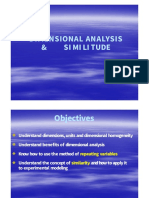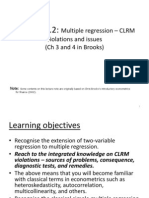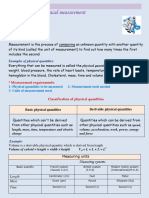L1 Handouts
Uploaded by
scarletfieldsL1 Handouts
Uploaded by
scarletfields3rd year uids and engineering analysis
Tristan Robinson
Department of Civil, Environmental and Geomatic Engineering
University College London
October 19, 2012
Table of contents
1 Dimensional analysis and similarity
Dimensions
Non-dimensional equations
Similarity
Buckingham - theorem
1 Dimensional analysis and similarity
Dimensions
Non-dimensional equations
Similarity
Buckingham - theorem
Dimensions and units
Dimension: Measure of a physical quantity (length (L), time
(T), mass (M)).
Units: Assignment of a number to a dimension ((m), (s),
(kg)).
7 Primary dimensions (SI Units)
1. Length Metre, m L
2. Mass Kilogram, kg M
3. Time Second, s T
4. Temperature Kelvin, K Q
5. Current Ampere, A I
6. Luminosity Candela C
d
7. Matter Mole N
Secondary units are made up from combinations of
primary units.
Dimensional analysis
Generate non-dimensional parameters that help in the
design of experiments (physical and/or numerical) and in
reporting of results
Obtain scaling laws so that prototype performance can be
predicted from model performance.
Common non-dimensional parameters
Name Interpretation Equation
Darcy friction factor, f
wall friction force
inertia force
8
w
U
2
Drag coefcient, C
D
drag force
dynamic force
F
D
1
2
U
2
A
Froude number, Fr
inertia force
gravitational force
U
gL
Reynolds number, Re
inertia force
viscous force
LU
Weber number, We
inertial force
surface tension force
U
2
L
s
L = characteristic length, A = characteristic area, U =
characteristic velocity, g = gravity, p = pressure, = viscosity,
= uid density,
w
= shear stress along a wall,
s
= surface
tension and F
D
= drag force.
The process of non-dimensionalising
equations
Law of dimensional homogeneity: every additive term in an
equation must have the same dimensions
If we divide each term in the equation by a collection of
variables that have the same dimensions, the equation is
rendered non-dimensional
In the process of non-dimensionalising an equation,
non-dimensional parameters ofter appear (ie Re and Fr)
Advantages of non-dimensionalisation
Increases insight about key parameters
Decreases number of parameters in the problem
1 Easier communication
2 Fewer experiments
3 Fewer simulations
Extrapolation of results to untested conditions
Non-dimensional Bernoulli equation
Dimensional Bernoulli equation
p +
U
2
2
+ gz = C
Primary dimensions
[p] = [MT
2
L
1
]; [] = [ML
3
]; [U] = [LT
1
];
[g] = [LT
2
]; [z] = [L]
Select scaling parameters (done by inspection)
p
=
p
0
U
2
0
0
U
=
U
U
0
g
=
gL
U
2
0
z
=
z
L
Substitute back into the Bernoulli equation
p
0
U
2
0
+
1
2
U
2
0
U
2
+
0
U
2
0
L
z
L = C
Non-dimensional Bernoulli equation
Divide by
0
U
2
0
and set
= 1 (incompressible condition)
p
+
1
2
U
2
+ g
= C
Since g
=
1
Fr
2
where Fr =
U
0
gL
p
+
1
2
U
2
+
1
Fr
2
z
= C
This is the non-dimensional Bernoulli equation.
Scaled according to the Froude number.
Different types of similarity models
Geometric similarity - each dimension must be scaled by
the same factor and hence the angles in the model are
equal to the prototype.
Kinematic similarity - velocity as any point in the model
must be proportional
Dynamic similarity - all forces in the model ow scale by a
constant factor to corresponding forces in the prototype
ow.
Complete similarity is achieved only if all 3 conditions are
met.
Complete similarity
This would require that both Fr
p,m
and Re
p,m
of the
prototype and model match
Re
p
=
U
p
L
p
p
= Re
m
=
U
m
L
m
L
m
L
p
=
m
U
p
p
U
m
Fr
p
=
U
p
_
gL
p
= Fr
m
=
U
m
_
gL
m
L
m
L
p
=
_
U
m
U
p
_
2
Hence
p
=
_
L
m
L
p
_3
2
The ratio of the viscosity is a function of the length scale.
More common is partial similarity when only similarity of
the most important effects are ensured.
Partial similarity
For hydraulic applications the depth is very small in
comparison to the horizontal dimensions. If geometric
similarity is used, the model depth would be so small that
surface tension effects (Weber number) would become
important.
Distorted models are therefore employed, which requires
empirical corrections/correlations to extrapolate model
data to full scale.
Buckingham - theorem
A fundamental question is how many dimensionless
products are required to replace the list of variables.
A system has k variables it can be described by k r
indepedent products, where r is the minimumn number of
reference dimensions required to describe the variables
The dimensionless producst are referred to as pi terms
(
1
,
2
. . .
kr
)
This method does not predict the exact mathematical form
of the equation.
Apply the - theorem
Dene the number of independent dimensional parameters
(n) governing the behaviour of the system.
Dene the primary dimensions (k). (usually length [L], time
[T] and mass [M]).
Number of non-dimensional parameters: m = n k.
Construct the non-dimensional groups
1
, . . . ,
m
as
products of unknown powers of dimensional parameters.
All groups are non-dimensional, that is the total power of
each dimension should be 0.
Example: Pipe ow
For the case of a fully developed pipe ow.
Generate a nondimensional relationship between shear
stress and other parameters.
Pipe ow: Parameters
Pipe diameter D
Incompressible uid of density and viscosity .
Fully developed velocity prole which remains uniform with
a constant average speed U.
Constant shear stress
0
on the inside pipe wall (ie
frictional force).
Constant average roughness height along the inside wall
of the pipe.
Pipe ow: Dimensions
Quantity Units Dimension
Dependent Shear stress
w
[ML
1
T
2
]
parameter
Independent Flow velocity U [LT
1
]
parameters Denisty [ML
3
]
Viscosity [ML
1
T
1
]
Roughness height [L]
Diameter D [L]
Primary Length D [L]
dimensions Time t [T]
Mass m [M]
Pipe ow: Repeated variables
The expected number of nondimensional functions () is
6
..
no. of parameters
3
..
no. of primary dimensions
= 3
..
1
,
2
,
3
.
Choose 3 repeating parameters
1 Cannot pick dependent variable.
2 Cannot pick parameters with the same dimensions.
3 Pick parameters that you can measure.
Let the repeating variables be U, D and
Generate the
1
,
2
and
3
functions
Pipe ow: Generate
1
Non-dimensional shear stress
1
=
w
U
a
D
b
c
Dimensions
[1] =
_
M
1
L
1
T
2
_ _
L
1
T
1
_
a
[L]
b
_
M
1
L
3
_
c
Power of each primary dimension should be 0
L : 1 + a + b 3c = 0
T : 2 a = 0
M : 1 + c = 0
We have a = 2, b = 0 and c = 1.
1
=
w
U
2
Pipe ow: Generate
2
Non-dimensional viscosity
2
= U
a
D
b
c
Dimensions
[1] =
_
M
1
L
1
T
1
_ _
L
1
T
1
_
a
[L]
b
_
M
1
L
3
_
c
Power of each primary dimension should be 0
L : 1 + a + b 3c = 0
T : 1 a = 0
M : 1 + c = 0
We have a = 1, b = 1 and c = 1.
2
=
UD
Pipe ow: Generate
3
Non-dimensional roughness
3
= U
a
D
b
c
Dimensions
[1] =
_
L
1
_ _
L
1
T
1
_
a
[L]
b
_
M
1
L
3
_
c
Power of each primary dimension should be 0
L : 1 + a + b 3c = 0
T : 0 a = 0
M : 0 + c = 0
We have a = 0, b = 1 and c = 0.
3
=
D
Final functional relationship
With
1
=
w
U
2
,
2
=
UD
and
3
=
D
Note we can re-write these terms has
1
=
w
U
2
8
w
U
2
= Darcy friction factor
2
=
UD
UD
= Reynolds number
3
=
D
D
= Roughness ratio
Final functional relationship
8
0
U
2
= f
_
Re,
D
_
Variation of friction factor
Summary of the - theorem
The system can be described by an equation connecting n
independent variables f (v
1
, v
2
, . . . , v
n
) = 0, where f is
some function and v
1
, v
2
, . . . , v
n
are the dimensional
variables.
The variables (v
1
, v
2
, . . . , v
n
) are constructed using k
primary dimensions d
1
, . . . , d
k
(ie length [L], mass [M] and
time [T])
Then there will be m = n k non-dimensional parameters.
Choose the k repeating parameters
Solution can be written as (
1
,
2
. . . ,
m
) = 0
Exercise: theorem
Find an expression of the elevation of a ball in a vacuum.
The elevation z of the ball must be a function of time t ,
initial vertical speed w
0
, initial elevation z
0
and gravitational
acceleration g
Find the height as a function of independent variables and
constants
z = f (t , w
0
, z
0
, g)
Ball in a vacuum: Dimensions
Quantity Units Dimension
Dependent Elevation z [L]
parameter
Independent Time t [T]
parameters Velocity w
0
[LT
1
]
Initial height z
0
[L]
Gravity g [LT
2
]
Primary Length z [L]
dimensions Time t [T]
Ball in a vacuum: Repeated variables
The expected number of nondimensional functions () is
5
..
no. of parameters
2
..
no. of primary dimensions
= 3
..
1
,
2
,
3
.
Choose 2 repeating parameters
1 Cannot pick dependent variable.
2 Cannot pick parameters with the same dimensions.
3 Pick parameters that you can measure.
Let the repeating variables be w
0
and z
0
Generate the
1
,
2
and
3
functions
Ball in a vacuum: Generate
1
Non-dimensional elevation
1
= zw
a
0
z
b
0
Dimensions
[1] = [L]
_
LT
1
_
a
[L]
b
Power of each primary dimension should be 0
L : 1 + a + b = 0
T : 0 a = 0
We have a = 0 and b = 1.
1
=
z
z
0
Ball in a vacuum: Generate
2
Non-dimensional time
2
= tw
a
0
z
b
0
Dimensions
[1] = [T]
_
L
1
T
1
_
a
[L]
b
Power of each primary dimension should be 0
L : a + b = 0
T : 1 a = 0
We have a = 1 and b = 1.
2
=
tw
0
z
0
Ball in a vacuum: Generate
3
Non-dimensional gravity
3
= gw
a
0
z
b
0
Dimensions
[1] =
_
LT
2
_ _
LT
1
_
a
[L]
b
Power of each primary dimension should be 0
L : 1 + a + b = 0
T : 2 a = 0
We have a = 2 and b = 1.
3
=
gz
0
w
2
0
Final functional relationship
With
1
=
z
z
0
,
2
=
tw
0
z
0
and
3
=
gz
0
w
2
0
Note we can re-write these terms has
1
=
z
z
0
z
z
0
= nondimensional elevation
2
=
tw
0
z
0
tw
0
z
0
= nondimensional time
3
=
gz
0
w
2
0
w
0
gz
0
= Froude number
Final functional relationship
z
z
0
= f
_
tw
0
z
0
,
w
0
gz
0
_
= f (t
, Fr )
Mathematical derivation
Object falling by gravity through a vacuum
d
2
z
dt
2
= g
with initial height z
0
and velocity w
0
in the z-direction.
Solve
z = z
0
+ w
0
t
1
2
gt
2
Non-dimensional
z
= 1 + t
1
2Fr
2
t
2
Advanced problem: Pumps
Quantity Units Dimension
Parameter Flow rate Q [L
3
T
1
]
Pressure head gH [L
2
T
2
]
Power P [ML
2
T
3
]
Speed of rotation N [T
1
]
Rotor diameter D [L]
Density [ML
3
]
Viscosity [ML
1
T
1
]
Primary Length D [L]
Time t [T]
Mass m [M]
Pump characteristic: Generate
1
Non-dimensional ow rate
1
= QD
a
N
b
c
Dimensions
[1] =
_
L
3
T
1
_
[L]
a
_
T
1
_
b
_
ML
3
_
c
Power of each primary dimension should be 0
L : 3 + a +3c = 0
T : 1 b = 0
M : 0 + c = 0
We have a = 3 b = 1 and c = 0.
1
=
Q
D
3
N
Pump characteristic: Generate
2
Non-dimensional pressure head
2
= gHD
a
N
b
c
Dimensions
[1] =
_
L
2
T
2
_
[L]
a
_
T
1
_
b
_
ML
3
_
c
Power of each primary dimension should be 0
L : 2 + a +3c = 0
T : 2 b = 0
M : 0 + c = 0
We have a = 2, b = 2 and c = 0.
2
=
gH
D
2
N
2
Pump characteristic: Generate
3
Non-dimensional power
3
= PD
a
N
b
c
Dimensions
[1] =
_
ML
2
T
3
_
[L]
a
_
T
1
_
b
_
ML
3
_
c
Power of each primary dimension should be 0
L : 2 + a 3c = 0
T : 3 b = 0
M : 1 + c = 0
We have a = 5, b = 3 and c = 1.
3
=
P
D
5
N
3
Pump characteristic: Generate
4
Non-dimensional viscosity
4
= D
a
N
b
c
Dimensions
[1] =
_
ML
1
T
1
_
[L]
a
_
T
1
_
b
_
ML
3
_
c
Power of each primary dimension should be 0
L : 1 + a 3c = 0
T : 1 b = 0
M : 1 + c = 0
We have a = 2, b = 1 and c = 1.
4
=
D
2
N
Exercise
Discuss your answer
Describe the relevance of each term
Exercise
1
=
Q
D
2
/ND
uid velocity
bladevelocity
Kinematic similarity of two
geomtrically similar machines is achieved if Q/ND
3
is the
same
3
=
3
1
=
Q
D
2
/
D
uid velocity
Reynolds number
4
=
4
2
= P/QgH
power transferred
turbine power
This
represents the hydraulic efciency
Exercise
You might also like
- Title: Unit V Turbulence and SimilarityNo ratings yetTitle: Unit V Turbulence and Similarity64 pages
- Lecture-Oct-2024-Dimensional-Analysis-1No ratings yetLecture-Oct-2024-Dimensional-Analysis-121 pages
- ME19Fluid MechanicsDimensional AnalysisNo ratings yetME19Fluid MechanicsDimensional Analysis26 pages
- Dimensional Analysis and Hydraulic SimilaritiesNo ratings yetDimensional Analysis and Hydraulic Similarities11 pages
- Primary Dimensions of Specific Heat at Constant Pressure:: AnalysisNo ratings yetPrimary Dimensions of Specific Heat at Constant Pressure:: Analysis9 pages
- Dimensional Analysis and simlitude - stdNo ratings yetDimensional Analysis and simlitude - std35 pages
- V. Modeling, Similarity, and Dimensional Analysis: E-Text Main Menu Textbook Table of ContentsNo ratings yetV. Modeling, Similarity, and Dimensional Analysis: E-Text Main Menu Textbook Table of Contents12 pages
- CIVL 306 Hydraulic Engineering - 1 IntroductionNo ratings yetCIVL 306 Hydraulic Engineering - 1 Introduction45 pages
- PHYS 291 Chapter 1: 1. What Is Physics? 2. What Do We Want From This Class? 3. Brief History of Physics 4. Chapter OneNo ratings yetPHYS 291 Chapter 1: 1. What Is Physics? 2. What Do We Want From This Class? 3. Brief History of Physics 4. Chapter One18 pages
- Dimensional Analysis: - Engineering EquationsNo ratings yetDimensional Analysis: - Engineering Equations11 pages
- PHYS 291 Chapter 1: 1. What Is Physics? 2. What Do We Want From This Class? 3. Brief History of Physics 4. Chapter OneNo ratings yetPHYS 291 Chapter 1: 1. What Is Physics? 2. What Do We Want From This Class? 3. Brief History of Physics 4. Chapter One18 pages
- Lecture 2 - Units, Measurements and Significant NumbersNo ratings yetLecture 2 - Units, Measurements and Significant Numbers33 pages
- Computational Modeling Techniques: Lecture 9: Dimensional Analysis Ion PetreNo ratings yetComputational Modeling Techniques: Lecture 9: Dimensional Analysis Ion Petre27 pages
- Dimensional Analysis: DR Neel Kanth Grover Associate ProfessorNo ratings yetDimensional Analysis: DR Neel Kanth Grover Associate Professor50 pages
- Numerical Modeling of Rock Deformation:: Dimensional AnalysisNo ratings yetNumerical Modeling of Rock Deformation:: Dimensional Analysis17 pages
- CFD Simulation of Mono Disperse Droplet Generation by Means of Jet Break-UpNo ratings yetCFD Simulation of Mono Disperse Droplet Generation by Means of Jet Break-Up20 pages
- Student Solutions Manual to Accompany Economic Dynamics in Discrete Time, secondeditionFrom EverandStudent Solutions Manual to Accompany Economic Dynamics in Discrete Time, secondedition4.5/5 (2)
- The Present Perfect Tense and Past PerfectNo ratings yetThe Present Perfect Tense and Past Perfect5 pages
- Bhaktivedanta_Vidyapitha_SB_Canto_10_OverviewNo ratings yetBhaktivedanta_Vidyapitha_SB_Canto_10_Overview208 pages
- Industrial Profile: Hutti Gold Mines Company LimitedNo ratings yetIndustrial Profile: Hutti Gold Mines Company Limited78 pages
- IMOmath - Functional Equations - Problems With SolutionsNo ratings yetIMOmath - Functional Equations - Problems With Solutions15 pages
- Climate Protection and Environmental Interests in Renewable Energy Law: Perspectives From Brazil and Germany Paula Galbiatti Silveira100% (2)Climate Protection and Environmental Interests in Renewable Energy Law: Perspectives From Brazil and Germany Paula Galbiatti Silveira49 pages
- Complete Download Algebraic Topology VIASM 2012 2015 1st Edition H.V. Hưng Nguyễn PDF All Chapters100% (6)Complete Download Algebraic Topology VIASM 2012 2015 1st Edition H.V. Hưng Nguyễn PDF All Chapters62 pages
- Primary Dimensions of Specific Heat at Constant Pressure:: AnalysisPrimary Dimensions of Specific Heat at Constant Pressure:: Analysis
- V. Modeling, Similarity, and Dimensional Analysis: E-Text Main Menu Textbook Table of ContentsV. Modeling, Similarity, and Dimensional Analysis: E-Text Main Menu Textbook Table of Contents
- PHYS 291 Chapter 1: 1. What Is Physics? 2. What Do We Want From This Class? 3. Brief History of Physics 4. Chapter OnePHYS 291 Chapter 1: 1. What Is Physics? 2. What Do We Want From This Class? 3. Brief History of Physics 4. Chapter One
- PHYS 291 Chapter 1: 1. What Is Physics? 2. What Do We Want From This Class? 3. Brief History of Physics 4. Chapter OnePHYS 291 Chapter 1: 1. What Is Physics? 2. What Do We Want From This Class? 3. Brief History of Physics 4. Chapter One
- Lecture 2 - Units, Measurements and Significant NumbersLecture 2 - Units, Measurements and Significant Numbers
- Computational Modeling Techniques: Lecture 9: Dimensional Analysis Ion PetreComputational Modeling Techniques: Lecture 9: Dimensional Analysis Ion Petre
- Dimensional Analysis: DR Neel Kanth Grover Associate ProfessorDimensional Analysis: DR Neel Kanth Grover Associate Professor
- Numerical Modeling of Rock Deformation:: Dimensional AnalysisNumerical Modeling of Rock Deformation:: Dimensional Analysis
- CFD Simulation of Mono Disperse Droplet Generation by Means of Jet Break-UpCFD Simulation of Mono Disperse Droplet Generation by Means of Jet Break-Up
- Student Solutions Manual to Accompany Economic Dynamics in Discrete Time, secondeditionFrom EverandStudent Solutions Manual to Accompany Economic Dynamics in Discrete Time, secondedition
- Industrial Profile: Hutti Gold Mines Company LimitedIndustrial Profile: Hutti Gold Mines Company Limited
- IMOmath - Functional Equations - Problems With SolutionsIMOmath - Functional Equations - Problems With Solutions
- Climate Protection and Environmental Interests in Renewable Energy Law: Perspectives From Brazil and Germany Paula Galbiatti SilveiraClimate Protection and Environmental Interests in Renewable Energy Law: Perspectives From Brazil and Germany Paula Galbiatti Silveira
- Complete Download Algebraic Topology VIASM 2012 2015 1st Edition H.V. Hưng Nguyễn PDF All ChaptersComplete Download Algebraic Topology VIASM 2012 2015 1st Edition H.V. Hưng Nguyễn PDF All Chapters

























































































